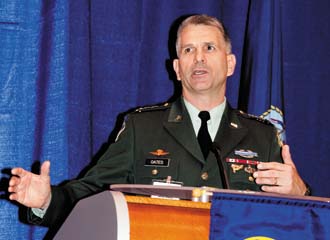 |
Lt. Gen. Michael L. Oates, USA, is the director of the Joint Improvised Explosive Device Defeat Organization. |
Military leaders agree that accurately predicting imminent warfighter needs is problematic but proper preparation is vital.
Coalition forces are on the threshold of attaining one goal they have sought to achieve for nearly a decade: persistent agility and perseverance. The stunning terrorist attack on the United States on September 11, 2001, is one in a list of terrorist assaults that occurred prior to that unprovoked assault and unfortunately persist. But it was that horrific event in September 2001 that solidified a multinational determination to fight a tenacious conglomerate of adversaries. Despite this focused objective, however, the challenges to collaborate are not as much about a lack of single-mindedness but rather the natural ungainliness that emerges when countries take on en masse combat.
To ensure that the warfighters of collaborating nations have the tools they need to triumph in the most likely future fighting scenarios, military, government and industry leaders meet regularly to discuss existing problems and solutions. Debate that took place among the participants at the AFCEA International/U.S. Naval Institute-sponsored Joint Warfighting 2010 conference, held in Virginia Beach, May 11-13, addressed some key issues that must be resolved to ensure that coalition partners can fight together more effectively. The event’s theme, “Combatant and Coalition Commanders: What Will They Need Five Years From Now?” reflected the shift from concentrating solely on current needs to working toward more cohesive fighting in the future. However, most participants agreed that the pace of technological change and the enemies’ agility make it difficult to predict accurately both how the future will unfold and what will be required to defeat adversaries throughout the next decade.
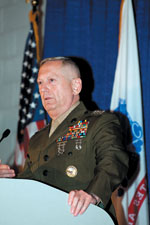 |
Gen. James N. Mattis, USMC, commander, U.S. Joint Forces Command, not only introduced each speaker during the conference but also shared his insights with Joint Warfighting 2010 conference attendees, giving them some issues to contemplate upon their return to their jobs. |
One look at the conference’s events program revealed how the discussion about fighting terrorists has evolved over the past five years. Rather than focusing only on practicalities such as interoperability, bandwidth, information sharing and defeating improvised explosive devices (IEDs), individual speakers and panelists covered overarching issues that must be resolved. Although these topics are still major points of concern, military and business leaders now recognize some of the specifics from the larger picture that also must be addressed to defeat terrorism.
Increasing information sharing among the joint and multinational forces topped many of the speakers’ and panelists’ lists of issues that must be resolved quickly—not from technical capabilities but rather by changing the way militaries do business. Lt. Gen. Michael L. Oates, USA, director, Joint Improvised Explosive Device Defeat Organization, described one concrete result of the inability to share information freely: casualties of IEDs. “Our enemies are using sophisticated means to attack, including collaborating with each other. Training gives us the highest return on investment. This is not an engineering problem. It is not an intelligence problem. It is a commander’s problem because information cannot be shared. We’ve got to find a way for tactical commanders to share information rapidly and thoroughly,” Gen. Oates said.
“Today, the IED is a condition of our workplace. Warfighters have got to be able to operate in these conditions. Although they can be very rudimentary, they are changing the way our commanders must operate,” he added
Although Secretary of Defense Robert Gates has stressed that the IED problem will continue, Gen. Oates pointed out that the 2010 Quadrennial Defense Review pays little attention to this weaponry. The general also predicted that IEDs will find their way into nonmilitary environments more frequently—like the New York Times Square incident—and not only terrorists but also drug lords and other criminals will use them.
Using a multitude of IEDs as “weapons of mini destruction” to disrupt life in the United States and European countries is only one part of an ill-defined future, which includes unknown activities from a less-predictable nation—China. As the Chinese continue to catapult forward, more international security challenges will surface, said Dr. Patrick Cronin, senior adviser and senior director, Asia-Pacific Security Program Center for a New American Security. Members of a panel led by Maj. Gen. Robert H. Scales, USA (Ret.), continued to visit the topic of China’s focus on an asymmetrical rise to power using cyberwarfare. Panel member Joe Purser, director, Joint Futures Group, U.S. Joint Forces Command (JFCOM), added that China has changed more in the past 40 years than any other nation in the world.
Fighting new types of battles will be a particular challenge as the United States’ usual military partners suffer financially. “Traditional allies won’t be traditional allies anymore” thanks to a lack of funds for burden sharing, Cronin stated. While the panelists agreed that the United States remains strong, it still needs to make serious changes and “clean up its economic house,” he added. As financial problems continue, the United States may not be able to continue providing the global security blanket it once did for the world, Cronin said.
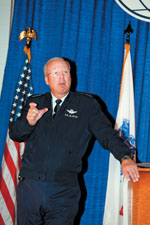 |
Gen. Craig R. McKinley, USAF, is the chief of the National Guard Bureau. |
Representatives from the British army, Italian army and
U.S. forces participated in a panel discussion where they candidly expressed their concerns about how current operations in
Southwest Asia are being conducted. These military men spoke with confidence, because each had served at least one tour of duty in
Afghanistan and/or
Iraq. Culture, language, information sharing and training were among their top concerns. Although multinational troops entered
Afghanistan to bring about democracy, from a local standpoint this action could be viewed as criticizing the residents’ way of life; this is a cultural rather than a military battle, panelists agreed.
Capt. Kirby R. Warms, USMC, a trainer embedded with the Afghan National Army, stated that often only academic answers are given to questions about how to operate with non-Western military forces. Cultural differences appeared quickly, as residents of Afghan towns showed little to no interest in learning about how to defend their villages more effectively. This was a very difficult problem to overcome, Capt. Warms shared.
Information sharing—both from technical and cultural standpoints—has been a major roadblock to troops serving in Afghanistan. According to Maj. Dino Mora, IA, a specialist in human intelligence and counterintelligence for NATO, allied nations agree that they must protect the sources of their intelligence, which often results in withholding information. However, most collaborating countries primarily are interested in the level of reliability of the information and not the source of it. Increasing information sharing between nations could save many lives, the major said.
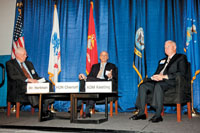 |
Using a discussion format, David Hartman (l), former Good Morning America host, posed questions to homeland security/homeland defense specialists: the Honorable Michael Chertoff (c), former secretary of the U.S. Department of Homeland Security, and Adm. Timothy J. Keating, USN (Ret.), former commander of U.S. Pacific Command. |
In what has become an enjoyable format for presentations, conference attendees had the pleasure of listening to the viewpoints of the Honorable Michael Chertoff, former secretary of the U.S. Department of Homeland Security, and Adm. Timothy J. Keating, USN (Ret.), former commander, U.S. Pacific Command, in a Meet the Press-style format. The former host of
Good Morning America, David Hartman, posed several pointed questions to both of these homeland security/homeland defense experts. The topic of cybersecurity revealed a nuance about the subject that is rarely discussed in open forums: an adversary’s intent. Chertoff and Adm. Keating agreed that certain governments leave the definition of cyberattack open ended so they can conduct certain activities without reproach. The two concurred that this is an area that requires additional study and action, and Chertoff emphasized that the time to move more concretely forward on this topic has arrived because cyberattacks are a “very real, consequential threat.”
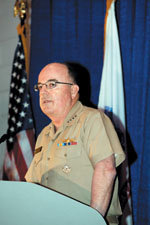 |
Adm. John C. Harvey Jr., USN,
is the commander of U.S. Fleet Forces Command. |
Adm. John Harvey, USN, commander, U.S. Fleet Forces Command, spoke about what most leaders believe is at the core of a successful military: its people. He emphasized that predicting what warfighters will need in five years is impossible. “No matter how military leaders try to accurately describe the future exactly right, the percentage of succeeding at this is exactly zero,” he stated. The admiral also said that the operational complexity and rapid change that warfighters experience today likely will continue, so preparing for uncertainty is essential. That said, Adm. Harvey stated that he is heartened by the amount of training that is ongoing, and he believes many of the tools that will be needed in 2015 already are in use or are being produced.
One of the highlights of Joint Warfighting 2010 was the use of videoconferencing to connect attendees in Virginia Beach with Gen. David H. Petraeus, USA, commander, U.S. Central Command (CENTCOM), who was being beamed to the convention center screen from an undisclosed location. Gen. Petraeus offered only a few opening remarks, and spent the majority of the hour answering attendees’ questions.
Although the general’s introduction was short, its content was extremely revealing to industry attendees. He explained that CENTCOM has identified several areas that need more attention in the near future. Among these are improvements in counterintelligence, human intelligence and intelligence analysis; persistent intelligence, surveillance and reconnaissance; counter-IED tactics; and in-theater command, control, communications and computers (C4) capabilities.
Given the opportunity to ask CENTCOM’s commander questions about any topic, luncheon attendees were interested in knowing the general’s opinion about events such as the foiled car bomb attempt in New York’s Times Square and its possible ties to Pakistan. Information sharing also was a topic brought to Gen. Petraeus’ attention, and he agreed that problems in this area will continue until a philosophical change occurs throughout militaries in both the joint and multinational worlds.
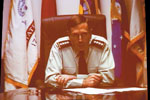 |
Gen. David H. Petraeus, USA, commander, U.S. Central Command, joined the Joint Warfighting 2010 conference via videoconferencing. He spoke for only a few minutes, then opened the floor for questions from the audience, a session that lasted nearly an hour. |
In addition to increased information sharing, the multinational forces in
Afghanistan must determine how to integrate numerous communications systems in the theater of operations, Gen. Petraeus said. “This is a crucial point; that is one of those capabilities that we need in the future,” he stated, referring to C
4 shortfalls.
Although difficult to top a videoconference conversation with the head of CENTCOM, a group of experts on small-unit excellence managed to do it by openly discussing what troops on the ground face today and will face in the future. All of the service branches are examining the possibility of operating in small groups organized in much the same way as special operations teams. However, panel members proposing what it will take to bring about small-unit excellence agreed that the first step will be eliminating outdated processes that govern the U.S. Defense Department.
From Master Chief Dan Marshall, USN, a Navy SEAL, to Maj. Gen. Stephen R. Layfield, USA, director, joint training directorate, JFCOM, all of the panelists agreed that small-unit excellence is a matter of processes, not doctrine. Activities on the battlefield take place so quickly that often warfighters do not have time to wait for written orders but must make decisions and take action guided by what they understand as their commander’s intent.
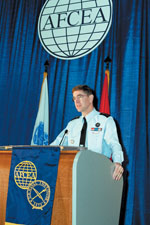 |
Gen. Stéphane Abrial, FAF, is the commander of NATO Supreme Allied Command Transformation. |
Among the non-U.S. key speakers was Gen. Stéphane Abrial, FAF, commander, NATO Supreme Allied Command Transformation. Gen. Abrial pointed out that while militaries of all nations must not ignore the immediate needs of today’s missions, they also must plan for the needs of military leaders who will fight battles up to a decade from today. He described some of the conditions coalition commanders will face in 2015. Although countries agree that partnerships are here to stay, it is important to accept that these coalitions should not always be brought together ad hoc. Instead, at the very least, NATO countries should share common practices and standards prior to collaborating in the battlespace.
In addition to the organizations that sponsor Joint Warfighting 2010, JFCOM provided a great deal of support. So it was apropos that Gen. James N. Mattis, USMC, JFCOM’s commander, was the final speaker at the conference. A fervent student of history, Gen. Mattis spoke openly about the threats, dangers, successes, failures, problems and solutions today’s militaries face because of the type of adversaries they are fighting. Not known for pulling any punches, the general referred several times to lessons that today’s militaries should have—but have not always—learned from past military tactics and terrorists.
“In this age, I don’t care how tactically or operationally ready you are, if you can’t create harmony across military, international and civilian lines, you need to go home, because your leadership is obsolete,” Gen. Mattis stated.
The media are tools that the enemy has learned to use and use well, he added. While terrorists are willingly spouting their causes and claims of responsibility for evil acts across airwaves and the Internet, U.S. and European military and government leaders remain silent. In some cases, this silence is justified for security reasons. In other cases, a public figure refuses to speak on the record with reporters because of being burned by them in the past or having been taken to task by superiors for speaking out. However, Gen. Mattis encouraged all members of the military to participate with the press so that accurate information is being shared with the public.
Photography by Michael Carpenter
WEB RESOURCE
SIGNAL Scape: www.afcea.org/signal/signalscape/index.php/tag/JWC10/











Comments